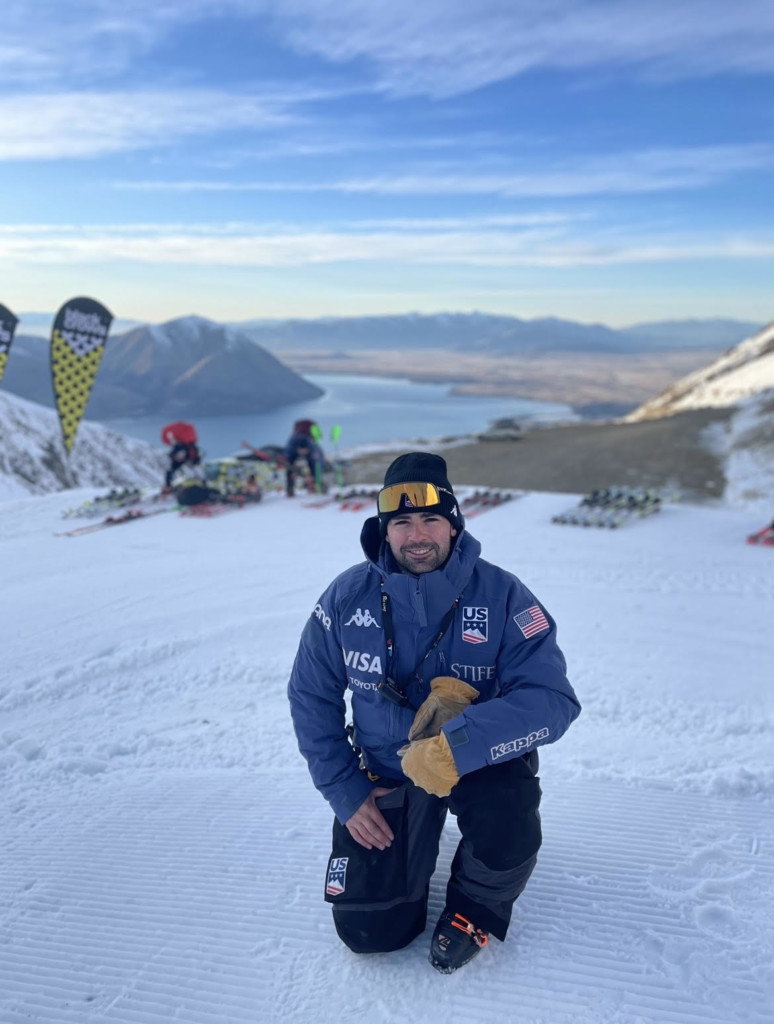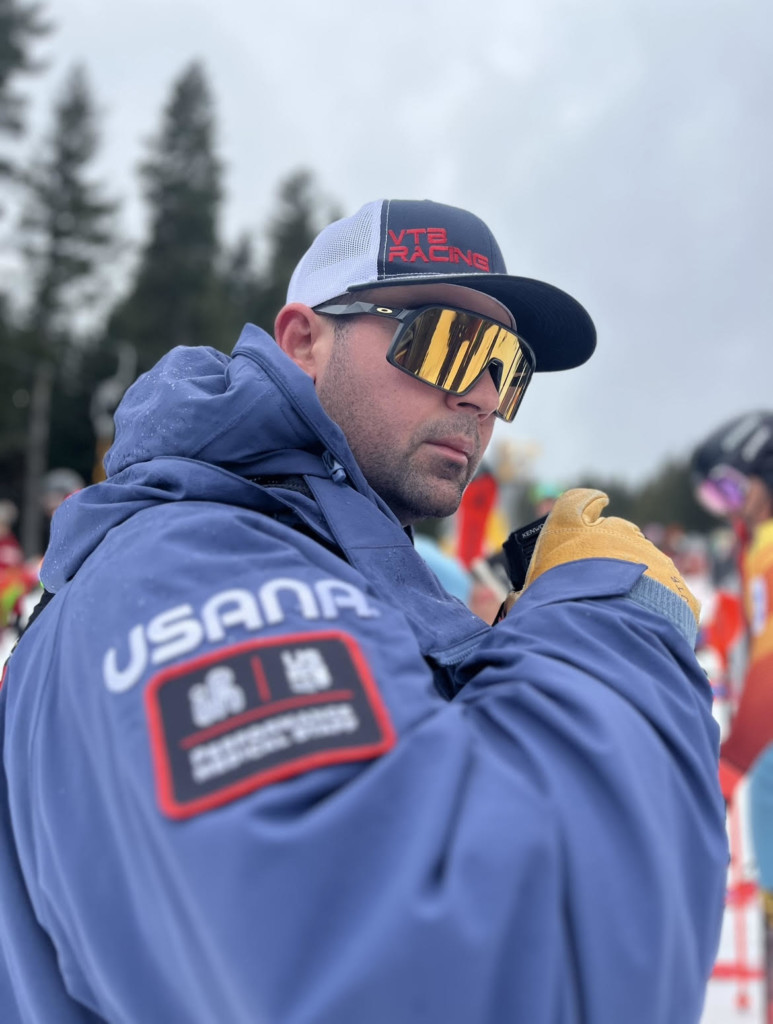About Vincent Corrado
“The reason I went to PT school was to one day work with the U.S. Ski Team,” said Vincent Corrado, who earned a Doctor of Physical Therapy degree at Russell Sage College. “I just kept trying to follow my dream and my passion, and here we are.”
Corrado — now the physical therapist for U.S. Ski & Snowboard’s Men’s Alpine World Cup Tech team — was speaking from Sölden, Austria, where he was working with athletes preparing for the 2024-25 FIS Alpine World Cup season opener in Giant Slalom.
In the following Q&A, he describes the combination of experience, education, and perseverance that helped him reach his goal.
How did you become affiliated with the U.S. Ski & Snowboard team?
I grew up ski racing in southern New York, about an hour outside of the city. My mountain was 300 vertical feet, a small mountain called Mount Peter.
Racing through high school brought me to racing in college. My undergraduate college in Vermont had an articulation agreement with Russell Sage’s Physical Therapy program.
After retiring from my race career, I started coaching at Mount Peter. I worked at a nearby physical therapy practice and exchanged possibly 400 follow up emails with the U.S. Ski Team over a few seasons, never taking “no” for an answer.
For my first rotation with the team in 2021, I volunteered for three weeks at our home base in Copper Mountain, Colorado. I took vacation time from work. About two months later, I got called to help with the World Junior Ski Championship at Panorama Mountain, Canada. I used vacation time again.
I continued to email the ski team about full-time positions and luckily, that spring, I got the call.
Growing up as a ski racer combined with my coaching career, I understand ski racing terminology. I understand proper body mechanics and how training and race days are supposed to function.
My expertise as a physical therapist and a former ski racer really helps me connect with my athletes. When an athlete says, “Hey, I am having trouble on the steep parts during a certain turn,” or “My outside ski is not gripping,” I’m able to use all my knowledge to determine if a deficit in their body mechanics could be contributing to the problem.
It’s my fourth year with the team. I love it. There’s nothing like standing on top of a mountain every day. Some of the most breathtaking views in the world. My morning commute is up a chair lift. It’s as cool and as incredible as I imagined it being.

When you’re on site, what’s a day like for you?
Anytime the athletes are on snow, I’m on snow.
We’re up around 6 a.m. The athletes are warming up. I head up the hill with the coaches and set up the venue for training, whether that’s setting up timing, setting up gates, setting up safety nets. Let’s say there was snow the night before, we’re making sure we’re down to a firm surface that’s conducive for racing.
Training starts around 9 a.m. While the athletes are training, I’m at the top of the hill checking on them. Before each athlete takes a run, I radio the coaches below to make sure the course is clear and that it’s a safe atmosphere.
If something was to go wrong, I would be that first responder. Luckily, we’ve had healthy athletes.
After we get off the hill, athletes make lunch, and do their recovery. Coaches start analyzing video and figuring out timing reports.
That’s when my PT treatments start. I’ll send out time slots. Some days, all of them want to show up; other days, one or two.
Around 7 p.m., we have a team meeting. Then we have dinner. After dinner, it’s time for bed, and we do it all again the next day.
How many athletes are you working with?
The full team is about 15 to 20 athletes. Within the full team, we have smaller subgroups that compete in different disciplines.
The Giant Slalom team this year is four athletes, and I am also working with the Slalom group of three athletes.
How did Russell Sage prepare for your career?
Sage was great.
The professors there really adapted to my learning style. I was never much of a textbook learner but more of a real-life scenario type. I had to put extra time into studying. If most students studied for one hour, I needed to study for two hours. But because Sage is small, I was able to email professors, and they were always willing to meet with me during office hours to go over concepts I may have been struggling with. The professors really did go the extra mile to help me succeed. They knew me by name. They knew I skied. They knew I loved it.
The professors were also practicing physical therapists in various types of clinic settings. Some worked in inpatient units, some were outpatient, some sports medicine, wound care, in neuro units, et cetera. Having multiple professors who were experts in their specific area of PT helped me learn how to apply concepts in real life.
And I have a group of classmates who I graduated with, who I still reach out to whenever I’m stuck with a patient. I’m able to say, “Hey, I have this patient, we’re looking at X, Y, and Z. What do you think?”
Now, tell us about the travel that comes with your work!
We spend the entire year chasing snow.
The season typically starts around the end of April with athletes testing equipment and working on fundamentals. During the summer months athletes will spend a few weeks at the Center of Excellence in Park City, Utah, where they complete dryland strength and conditioning camps, along with physical testing and annual medical exams.
In August we’ll go to New Zealand because in the southern hemisphere, it’s wintertime. If we’re not in New Zealand, we’ll go to Argentina, to Ushuaia, which is the most southern city in the world.
In September we take some time off, and then we’ll shoot over to the glaciers in Europe, typically Saas-Fee in Switzerland. Since it is a glacier, there’s snow year round.
Then the World Cup opener is at the end of October, here in Sölden, Austria.
From here, the World Cup season starts picking up, so we’ll bounce around Europe. We’ll go up to Scandinavia, to the Arctic Circle, in early November for training and races. We then fly to Colorado around Thanksgiving.
In December, we come back to Europe until the end of March.
Usually, there’s a few stops in the U.S. throughout the season: Killington in Vermont and Beaver Creek in Colorado. Around February or March, we usually spend time in Palisades Tahoe, out in California, or Aspen, Colorado for races. This season we host the World Cup Finals in Sun Valley, Idaho, which should be fun!

Do you get to ski yourself?
Yes and no. I joke that I spend more time standing at the top of the hill than actually skiing during training days!
But every year, I track my days on snow! I have 23 or 24 days on snow already this year, and it’s only the middle of October.
Are you preparing for other milestones right now?
We’re in full swing for the 2026 Winter Olympics. The ski races will occur in Bormio and Cortina, Italy.
Next season should be a smooth transition into the Olympic games. The athletes are getting strong, figuring out what equipment they need, what their warm ups should be, their workouts. We’re trying to get everything dialed in now.
Is there anything you’d like to add?
I want to thank Sage for giving me the opportunity to follow my dreams.
If I could do any job in the world it would still be this. For PTs, whether we’re getting somebody to walk for the first time after a knee replacement or a stroke, or helping a professional athlete get their second chance at doing what they love after an injury, it’s rewarding.


